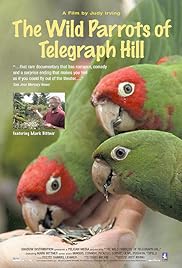WILD PARROTS OF TELEGRAPH HILL, THE
(director/writer: Judy Irving; screenwriter: based on the book by Mark Bittner; cinematographer: Judy Irving; editor: Judy Irving; music: Chris Michie; cast: Mark Bittner (himself), Connor, Olive, Mingus, Picasso, Sophie, Pushkin, Tupelo (all parrots); Runtime: 83; MPAA Rating: G; producer: Judy Irving; Shadow Distribution; 2003)
“Affectionate thought-provoking documentary, filmed in a relaxing informal manner.”
Reviewed by Dennis Schwartz
Judy Irving’s highly pleasing unique documentary, shot the old-fashioned way without digital effects (in 16mm and blown up to 35mm for release), offers a sensitive treatment on the subject of the relationships between birds and the warm-hearted, spiritual, bird-fancying Mark Bittner of San Francisco’s Telegraph Hill, while at the same time it also reflects on a city that makes an extra effort to care about our feathered friends. The genuinely affectionate thought-provoking documentary, filmed in a relaxing informal manner, is based on the book by Mark Bittner, who started out feeding 25 or so wild green parrots and after three or so years ended up feeding around 160 (most are cherry-headed conures except for a female mitred conure and a blue-crown conure). They are from the tropical climate of South America and have somehow found their way to Mark’s North Beach neighborhood (the most likely scenario presented is that they escaped from a pet store and then were able to exist on their own in the cold and breed in the city because they could always find enough food–never needing a caretaker).
Mark arrived 25 years ago from Seattle to be a professional musician but due to a lack of talent never made it, and has come to accept his homeless fate with the spirit of his Buddhist beliefs that to be happy one must find the Right Living (one that is suitable for his skills and one that helps humanity). The gentle redhaired caretaker is a ponytailed (won’t cut his hair until he gets a girlfriend) 50-ish unemployed bohemian type, with no visible means of support, who since 1994 tends to the wild parrot flock that live in his neighborhood out of a love and curiosity for the independent-minded birds. Mark pays for the feed himself and keeps in his house the sick ones and an oddball like Mingus, who prefers being inside. One of the sadder stories is about Mark’s favorite, the stand-offish single blue-crowned member of the flock, Connor, who was never accepted by the majority red-headed birds and eventually was taken as prey by a hawk.
Mark got involved with the parrots after reading nature/Zen poet Gary Snyder’s book Turtle Island (the poet lived in the area in the 1950s) and was impressed with the poet’s view that the study of nature should begin where one is at. The affable, well-read and well-spoken Mark lives in an almost bare rent-free cottage on a luxury estate (his landlords have not asked him for the rent, considering him an important part of the artistic neighborhood’s local flavor).
Having no practical background in ornithology when he first encountered the parrots, Mark has conducted his own research after finding no one else in town was interested in studying birds that are not native to the area. Mark names the parrots, discovers distinct personality traits among them, and that they have feelings over death, pain and love much like humans.
It’s a very touching story that moves from a simple tale about a homeless person caring for birds to something more wise, as it tells us a lot about humanity and what are its lasting values. Mark admits to anthropomorphizing and loving the birds with a real affection, and weeping with the loss of Tupelo–the first parrot to die under his watch. His sharp poetical observations indicate subtle but important connections between the birds—which pair up out of the need for love and protection, exhibit individual eccentricities, and fall victim to diseases and predators—to the San Francisco citizens.
I enjoyed this film even better than the recent wonderful documentary Winged Migration, mainly because it was less about birders than about a free-spirited spiritual person finding his calling in life by connecting as best he could with his inner bliss. The human interest story transcends the nature film and leaves one with an indelible impression on the connection between nature and humanity. The story ends in flux, as Mark is evicted as a squatter by his landlord who renovates his property and offers Mark no chance to return. The birds are still free to roam in the hills of San Francisco and reportedly are doing fine, while Mark moves on to another stage in his life (that comes as a sweet surprise at the conclusion).

REVIEWED ON 5/8/2005 GRADE: A+